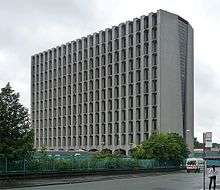Hexagon Tower
Hexagon Tower is a specialist science and technology facility located in Blackley, North Manchester, United Kingdom.

The site is a former Imperial Chemical Industries (ICI) research, development and production centre. Facilities at Blackley have played host to enterprises since 1785, before becoming an integral part of the British Dyestuffs Corporation after 1919 and then ICI in 1926.
Following a purchase in 2008,[1] Hexagon Tower is now part of the Business Environments for Science and Technology (BEST) Network of UK science parks, managed by LaSalle Investment Management.
History
1785–1926
The site in which Hexagon Tower is located has a long industrial heritage. The first enterprise to locate in the area was the Borelle Dyeworks, established by French Émigré Louis Borelle in 1785 to produce the ‘Turkey Red’ dye.[2]
Following a period of decline, the site was taken over by another French expatriate, Angel Raphael Louis Delaunay, who arrived in the area at the turn of the 19th Century to establish his own dyeing business in Blackley.[2]
Following the death of Delaunay’s son and heir Louis, German chemical entrepreneur Ivan Levinstein bought the dyeworks in 1865, leading to a period of commercial success for the site.[2] Besides his dying business, Levinstien was also famed for opening the Sackville Street Building and founding Wrexham Lager.
In 1919, Ivan Levinstein’s operation at Blackley merged with other chemical dyers to form the British Dyestuffs Corporation Limited,[2] before becoming part of ICI in 1926.[2]
ICI ownership
The ICI was founded in December 1926 from the merger of four companies: Brunner Mond, Nobel Explosives, the United Alkali Company, and British Dyestuffs Corporation.[3] Since then, the Blackley Dyeworks site was integrated into the chemical giant’s Specialty Chemicals division[2]
Under ICI stewardship of the Blackley Dyeworks, architect Richard Seifert was commissioned to build Hexagon Tower, with construction completed in 1973.[4] The 14-story tower was named after the hexagon shaped windows based on the chemical compound Benzene which is widely used in the creation of synthetic dyes.[5]
During its height in the 1960s, more than 14,000 people were employed at the site.[4] However, after growing competition from East Asian dye markets, the Specialty Chemicals division of ICI at Hexagon Tower passed ownership over to Zeneca in the mid-1990s.
Zeneca's move into pharmaceuticals saw Hexagon Tower become Avecia's international headquarters when it was bought by the company in 1999.
LaSalle Investment Management
In 2008, LaSalle Investment Management – an independent subsidiary of Jones Lang LaSalle – purchased Hexagon Tower on behalf of a pension fund client.
LaSalle has turned the facility into a multi-let science park, accommodating a range of tenants from SMEs such as Colour Synthesis Solutions to multi-national firms, including Intertek.[6][7]
The site now consists of 157,283 sq ft of machine halls, laboratories and office space over 13 floors and a lower ground level with multi-purpose laboratory space.[8]
Hexagon Tower received an International Standards Organisation certification for its environmental responsibility in January 2014.
Timeline of the Blackley Works and Hexagon Tower
- 1785 – The first industrial enterprise at Blackley, the Borelle Dyeworks, establishes, and later becomes Delaunay Dyeworks which was known for producing 'Turkey Red' dye.
- 1865 – Nearly a century after it was first established, the dyeworks is taken over by German commercial science entrepreneur Ivan Levinstein.
- 1919 (June) – After 54 years as Levinstein Ltd., the company merges with British Dyes to become the British Dyestuffs Corporation, controlling 75% of dye production in the UK.
- 1926 – British Dyestuffs Corporation merges with several other commercial chemical enterprises to form Imperial Chemical Industries, which would work at the Blackley site for the next 67 years.
- 1971 – Richard Seifert is commissioned to design Hexagon Tower, with the building completed in 1973.
- 1993 – ICI sells off the Specialty Chemicals division to the Zeneca Group, including Hexagon Tower, as part of its Fine Chemicals division.
- 1999 – Hexagon Tower is sold to Avecia, and establishes its headquarters there, as AstraZeneca moves into pharmaceuticals.
- 2008 – Avecia sells Hexagon Tower, with management passing to LaSalle Investment Management, which establishes the facility as a science park, providing a base for small start-up organisations to multinational businesses.
- 2013 – Hexagon Tower is incorporated into the BEST Network.
- 2016 - Hexagon Tower is sold to AV Hexagon BV
References
- "Hexagon Tower, Manchester". Manchester: Hexagon Tower. Retrieved 16 November 2016.
- "Turkey Red Dyeing in Blackley The Delaunay Dyeworks". ColorantsHistory.Org. Retrieved 16 November 2016.
- ICI: History, Archived from the original on October 17, 2008.
- "Hexagon Tower, Manchester". www.hexagon-tower.co.uk. Retrieved 2016-11-21.
- "British Dyestuffs Corporation and ICI". www.colorantshistory.org. Retrieved 2016-11-21.
- "Colour Synthesis Solutions - Experts in Custom Synthesis, Contract Research & Process Development". Colour Synthesis Solutions. Retrieved 2016-11-21.
- "Contact Information for the United Kingdom (UK)". www.intertek.com. Retrieved 2016-11-21.
- "Hexagon Tower, Manchester | Facilities and Support". www.hexagon-tower.co.uk. Retrieved 2016-11-21.